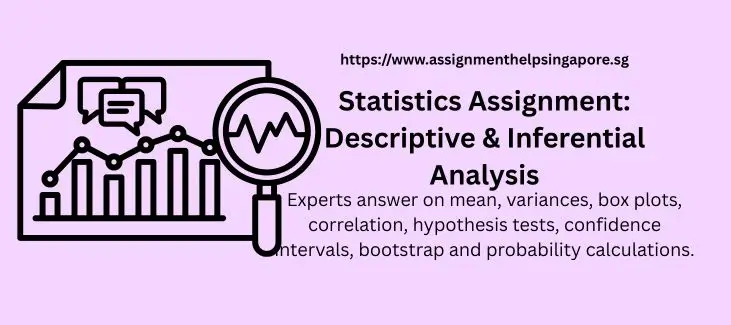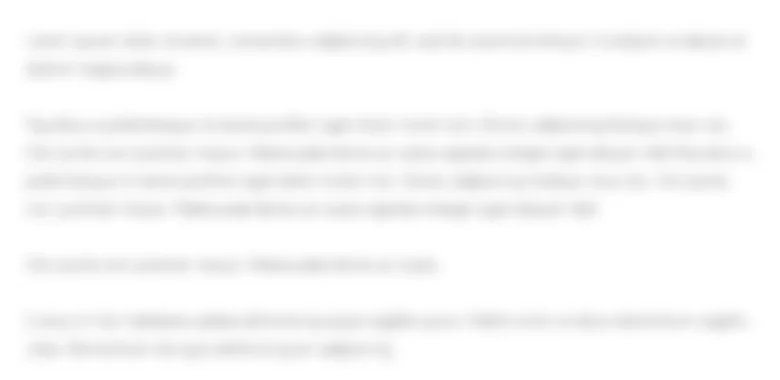
Contents
Statistics Assignment: Descriptive & Inferential Analysis
Question 1
The height and weight of 10 students were measured and the data is shown in Table 1.
| Students | 1 | 2 | 3 | 4 | 5 | 6 | 7 | 8 | 9 | 10 |
| Height (cm) | 174 | 166 | 173 | 160 | 162 | 180 | 175 | 177 | 164 | 170 |
| Weight (kg) | 77 | 60 | 75 | 50 | 55 | 80 | 77 | 79 | 52 | 69 |
Table 1: Height and Weight of Students
- Describe the data from Table 1 by calculating the mean, variance and standard deviation of the height and weight. Round all numbers to TWO (2) decimal places.
(5 marks)
- Use software to generate the boxplots for both height and weight. Interpret the plots and check for outliers.
(5 marks)
- Use software to generate a scatter plot for weight vs height with the weight on the vertical axis. Thereafter, calculate the correlation coefficient between weight and height.
(5 marks)
- Show the mathematical proof that if the unit of measurement for height is change from centimetre to feet, the correlation coefficient will not be affected.
(5 marks)
Question 2
- A factory produces light bulbs, and 95% of the light bulbs pass quality control while 5% are defective. If a quality control inspector randomly selects 10 light bulbs for inspection,
- What is the probability that exactly 2 of the selected light bulbs are defective?
(5 marks)
- What is the probability of finding more than 2 defective bulbs in the sample of 10?
(5 marks)
- The mean score of an entire cohort of students for a course is 67.8 with standard deviation (
) of 11.5. Apply the normal distribution,
- Find the probability of students scoring higher than 70 marks for this course.
(5 marks)
- If 25% of the cohort were awarded A grade, what is the lowest possible score for an A grade? Round the number to a whole number.
(5 marks)
Question 3
Table 3 shows the scores for an exam for a sample of 25 students from the Class of 2025 and another sample of 25 students from the Class of 2024.
| S/No | Class of 2025 | Class of 2024 |
| 1 | 70 | 50 |
| 2 | 64 | 41 |
| 3 | 46 | 87 |
| 4 | 57 | 75 |
| 5 | 40 | 66 |
| 6 | 74 | 41 |
| 7 | 83 | 65 |
| 8 | 59 | 63 |
| 9 | 67 | 78 |
| 10 | 49 | 63 |
| 11 | 45 | 69 |
| 12 | 60 | 72 |
| 13 | 55 | 72 |
| 14 | 47 | 66 |
| 15 | 63 | 47 |
| 16 | 77 | 90 |
| 17 | 46 | 52 |
| 18 | 53 | 77 |
| 19 | 57 | 51 |
| 20 | 53 | 55 |
| 21 | 60 | 42 |
| 22 | 74 | 54 |
| 23 | 84 | 90 |
| 24 | 58 | 58 |
| 25 | 85 | 61 |
Table 3: Exam Scores for Class of 2025 and 2024
- Apply a statistical method and calculate the upper and lower limit for a 95% confidence interval for the data from the Class of 2025.
(5 marks)
- Apply a statistical method and calculate the upper and lower limit for a 95% confidence interval for the data from the Class of 2024.
(5 marks)
- Interpret the two confidence intervals determine if there is any difference between the scores of 2025 versus 2024.
(5 marks)
- Using the data from Table 3, generate a 95% confidence interval for 2024 and 2025 using the bootstrapping method. Use numpy.random.seed(88) and repeat the bootstrap process 5000 times. Show the new confidence intervals and the Python codes in your writeup.
(5 marks)
Question 4
Due to work commitments, 20 students did not pass a course in the July 2024 semester. They repeated the same course in January 2025 and their scores in January 2025 and July 2024 are shown in Table 4.
| Students | Jan 2025 | Jul 2024 |
| 1 | 63.00 | 14.00 |
| 2 | 72.00 | 8.00 |
| 3 | 66.00 | 21.00 |
| 4 | 55.00 | 26.00 |
| 5 | 75.00 | 32.00 |
| 6 | 40.00 | 24.00 |
| 7 | 44.00 | 9.00 |
| 8 | 40.00 | 30.00 |
| 9 | 60.00 | 7.00 |
| 10 | 75.00 | 15.00 |
| 11 | 44.00 | 26.00 |
| 12 | 71.00 | 19.00 |
| 13 | 71.00 | 13.00 |
| 14 | 54.00 | 13.00 |
| 15 | 40.00 | 34.00 |
| 16 | 54.00 | 5.00 |
| 17 | 70.00 | 33.00 |
| 18 | 67.00 | 9.00 |
| 19 | 62.00 | 28.00 |
| 20 | 48.00 | 28.00 |
Table 4: Scores From July 2024 and January 2025 Semester
- Determine whether the data provided in Table 4 represents independent or dependent samples and explain your reasoning.
(5 marks)
- Apply an appropriate hypothesis test at 5% significance level to test whether students who repeated a course will improve their grades by at least 10 points. Conduct the test in a step-by-step manner.
(10 marks)
- Interpret the results for this test.
(5 marks)
Question 5
A nutritionist claims that the average sugar content in a popular brand of energy bars is 15 grams. To test this claim, a researcher randomly selects 10 energy bars of this brand and measures their sugar content (in grams). The data is shown in Table 5 and assumes the sugar content in energy bars is normally distributed.
| 14.2 | 15.8 | 14.9 | 14.8 | 16.1 | 15.3 | 14.8 | 15.6 | 15.8 | 14.9 |
Table 5: Weigths of 10 Enery Bars
- Apply a statistical method and calculate the upper and lower limit for a 95% confidence interval for the sugar content. Is the claim of 15 grams reasonable?
(5 marks)
- Apply an appropriate hypothesis test at 5% significance level to test whether the mean sugar content is equal to 15 grams. Conduct the test in a step-by-step manner.
(10 marks)
- Interpret the results for this experiment.
(5 marks)
Statistics Assignment Answers: Experts Answer on Above Descriptive & Inferential Analysis
Descriptive statistics and correlation
The calculation of mean, variance and standard deviation shows that the mean for height is 170.1 and weight is 69.9. The variance for height is 47.43 nd weight is 96.3 and standard deviation for height is 6.89 and weight is 9.82
Box plot interpretation
With respect to height, the boxplot is identified as symmetrical and there are no outliers identified. The weight shows slightly right skewed, and from this analysis it is evaluated that the height and weight of the majority of the students are within normal variation.
Caterplot and correlation
The scatter plot indicates a moderate positive linear relationship, as it is identified that taller students have higher weights. The correlation Coefficient is calculated is .78 which shows a strong positive correlation. The analysis also indicates that the correlation is not affected by the change in the unit.
Probability and normal distribution
In case of defective light bulb, the n is 10 and p is 0.05. P(X-2) = 0.0116
Normal distribution
The lowest A grade is identified as 76 marks, and 42.5% of students scored above 70.
| Disclaimer: This answer is a model for study and reference purposes only. Please do not submit it as your own work. |
Want a Full Worked Out Answer with References?
Related answers
Inferential Analysis of Customer Satisfaction Scores
Debt Repayment Strategies: Snowball vs Avalanche
HBC203 Statistics — Instagram, Emotions & Life Satisfaction
IST IoT Sensor Accuracy Analysis | BSE vs TSC for BCA
Workplace Wellbeing & Productivity: Statistical Analysis
Exercise Duration & Activity Analysis Among Singapore Youth



